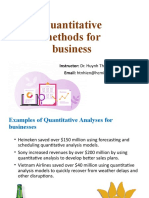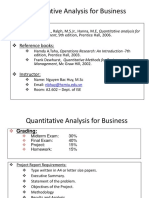SPD4524 Decision Analysis: Lecture 01 - Introduction
Uploaded by
CharlesSPD4524 Decision Analysis: Lecture 01 - Introduction
Uploaded by
CharlesSPD4524 Decision Analysis
Lecture 01 - Introduction
SPD4524 - L01 - Introduction 1
Learning Objectives
• After completing this chapter, students will be
able to:
– Describe the quantitative analysis approach
– Understand the application of quantitative analysis in
a real situation
– Describe the use of modeling in quantitative analysis
– Use computers and spreadsheet models to perform
quantitative analysis
– Discuss possible problems in using quantitative
analysis
– Perform a break-even analysis
SPD4524 - L01 - Introduction 2
Chapter Outline
• Introduction
• What Is Quantitative Analysis?
• The Quantitative Analysis Approach
• How to Develop a Quantitative Analysis Model
• The Role of Computers and Spreadsheet Models
in the Quantitative Analysis Approach
• Possible Problems in the Quantitative Analysis
Approach
• Implementation — Not Just the Final Step
SPD4524 - L01 - Introduction 3
Introduction
• Mathematical tools have been used for
thousands of years.
• Quantitative analysis can be applied to a wide
variety of problems.
– It’s not enough to just know the mathematics of a
technique.
– One must understand the specific applicability of
the technique, its limitations, and its assumptions.
SPD4524 - L01 - Introduction 4
Examples of Quantitative Analyses
• In the mid 1990s, Taco Bell saved over $150
million using forecasting and scheduling
quantitative analysis models.
• NBC television increased revenues by over $200
million between 1996 and 2000 by using
quantitative analysis to develop better sales plans.
• Continental Airlines saved over $40 million in
2001 using quantitative analysis models to
quickly recover from weather delays and other
disruptions.
SPD4524 - L01 - Introduction 5
What is Quantitative Analysis?
• Quantitative analysis is a scientific approach
to managerial decision making in which raw
data are processed and manipulated to
produce meaningful information.
Quantitative Meaningful
Raw Data Analysis Information
SPD4524 - L01 - Introduction 6
What is Quantitative Analysis?
• Quantitative factors are data that can be accurately
calculated. Examples include:
– Different investment alternatives
– Interest rates
– Inventory levels
– Demand
– Labor cost
• Qualitative factors are more difficult to quantify but
affect the decision process. Examples include:
– The weather
– State and federal legislation
– Technological breakthroughs (e.q. quantum computing).
SPD4524 - L01 - Introduction 7
The Quantitative Analysis Approach
Your Integrated Study is following the same steps
Defining the Problem
Developing a Model
Acquiring Input Data
Developing a Solution
Developing and testing Hypothesis
Testing the Solution
Analyzing the Results
Implementing the Results
SPD4524 - L01 - Introduction 8
Defining the Problem
• Develop a clear and concise statement that gives
direction and meaning to subsequent steps.
– This may be the most important and difficult step.
– It is essential to go beyond symptoms and identify
true causes.
– It may be necessary to concentrate on only a few of
the problems – selecting the right problems is very
important
– Specific and measurable objectives may have to be
developed.
SPD4524 - L01 - Introduction 9
Developing a Model
• Quantitative analysis models are realistic,
solvable, and understandable mathematical
representations of a situation.
$ Sales
$ Advertising
• There are different types of models:
Scale Schematic
models models
SPD4524 - L01 - Introduction 10
Developing a Model
Y1+Y2+...=α+aX1+bX2+...
DV IV
• Models generally contain variables
(controllable and uncontrollable) and
parameters.
– Controllable variables are the decision variables
and are generally unknown.
• How many items should be ordered for inventory?
• Parameters are known quantities that are a
part of the model.
– What is the holding cost of the inventory?
SPD4524 - L01 - Introduction 11
Acquiring Input Data
• Input data must be accurate – GIGO rule:
Garbage
In
Process
Garbage
Out
• Data may come from a variety of sources such as
company reports, company documents,
interviews, on-site direct measurement, or
statistical sampling.
SPD4524 - L01 - Introduction 12
Developing a Solution
• The best (optimal) solution to a problem is found by
manipulating the model variables until a solution is
found that is practical and can be implemented.
• Common techniques are
– Solving equations.
– Trial and error – trying various approaches and picking the
best result.
– Complete enumeration – trying all possible values.
– Using an algorithm – a series of repeating steps to reach a
solution.
SPD4524 - L01 - Introduction 13
Testing the Solution
• Both input data and the model should be
tested for accuracy before analysis and
implementation.
– New data can be collected to test the model.
– Results should be logical, consistent, and
represent the real situation.
SPD4524 - L01 - Introduction 14
Analyzing the Results
• Determine the implications of the solution:
– Implementing results often requires change in an
organization.
– The impact of actions or changes needs to be studied
and understood before implementation.
• Sensitivity analysis determines how much the
results will change if the model or input data
changes.
– Sensitive models should be very thoroughly tested.
– For example: elasticity
SPD4524 - L01 - Introduction 15
Implementing the Results
• Implementation incorporates the solution into
the company.
– Implementation can be very difficult.
– People may be resistant to changes.
– Many quantitative analysis efforts have failed because
a good, workable solution was not properly
implemented.
• Changes occur over time, so even successful
implementations must be monitored to
determine if modifications are necessary.
SPD4524 - L01 - Introduction 16
Modeling in the Real World
• Quantitative analysis models are used
extensively by real organizations to solve real
problems.
– In the real world, quantitative analysis models can
be complex, expensive, and difficult to sell.
– Following the steps in the process is an important
component of success.
SPD4524 - L01 - Introduction 17
How To Develop a Quantitative
Analysis Model
• A mathematical model of profit:
• Profit = Revenue – Expenses
SPD4524 - L01 - Introduction 18
How To Develop a Quantitative
Analysis Model
• Expenses can be represented as the sum of fixed and
variable costs. Variable costs are the product of unit
costs times the number of units.
SPD4524 - L01 - Introduction 19
• The parameters of this model are f, v, and s as
these are the inputs inherent in the model
• The decision variable of interest is X
SPD4524 - L01 - Introduction 20
Pritchett’s Precious Time Pieces
• The company buys, sells, and repairs old clocks. Rebuilt
springs sell for $10 per unit. Fixed cost of equipment to
build springs is $1,000. Variable cost for spring material is
$5 per unit.
• If sales = 0,
– profits = -f = –$1,000.
• If sales = 1,000,
– profits = [(10)(1,000) – 1,000 – (5)(1,000)] = $4,000
SPD4524 - L01 - Introduction 21
Pritchett’s Precious Time Pieces
• Companies are often interested in the break-even
point (BEP). The BEP is the number of units sold that
will result in $0 profit.
or
• Solving for X, we have
SPD4524 - L01 - Introduction 22
Pritchett’s Precious Time Pieces
• BEP for Pritchett’s Precious Time Pieces
– BEP = $1,000/($10 – $5) = 200 units
– Sales of less than 200 units of rebuilt springs will
result in a loss.
– Sales of over 200 units of rebuilt springs will result in a
profit.
SPD4524 - L01 - Introduction 23
Advantages of Mathematical Modeling
• Models can accurately represent reality.
• Models can help a decision maker formulate
problems.
• Models can give us insight and information.
• Models can save time and money in decision
making and problem solving.
• A model may be the only way to solve large or
complex problems in a timely fashion.
• A model can be used to communicate problems
and solutions to others.
SPD4524 - L01 - Introduction 24
Models Categorized by Risk
• Mathematical models that do not involve risk
are called deterministic models.
– All of the values used in the model are known
with complete certainty.
• Mathematical models that involve risk, chance,
or uncertainty are called probabilistic models.
– Values used in the model are estimates based on
probabilities.
SPD4524 - L01 - Introduction 25
Computers and Spreadsheet Models
• QM for Windows
– An easy to use decision support system for use in
Production and Operations Management(POM)
and QM courses
– This is the main menu of quantitative models
SPD4524 - L01 - Introduction 26
SPD4524 - L01 - Introduction 27
Computers and Spreadsheet Models
• Excel QM’s Main Menu (2010)
– Works automatically within Excel spreadsheets
SPD4524 - L01 - Introduction 28
Selecting Break-Even Analysis in Excel QM
SPD4524 - L01 - Introduction 29
Break-Even Analysis in Excel QM
SPD4524 - L01 - Introduction 30
Using Goal Seek in the Break-Even Problem
SPD4524 - L01 - Introduction 31
Possible Problems in the Quantitative
Analysis Approach
• Defining the problem
– Problems may not be easily identified.
– There may be conflicting viewpoints
– There may be an impact on other departments.
– Beginning assumptions may lead to a particular
conclusion.
– The solution may be outdated.
• Developing a model
– Manager’s perception may not fit a textbook model.
– There is a trade-off between complexity and ease of
understanding.
SPD4524 - L01 - Introduction 32
Possible Problems in the Quantitative
Analysis Approach
• Acquiring accurate input data
– Accounting data may not be collected for quantitative
problems.
– The validity of the data may be suspect.
• Developing an appropriate solution
– The mathematics may be hard to understand.
– Having only one answer may be limiting.
• Testing the solution for validity
• Analyzing the results in terms of the whole
organization
SPD4524 - L01 - Introduction 33
Implementation –
Not Just the Final Step
• There may be an institutional lack of
commitment and resistance to change.
– Management may fear the use of formal analysis
processes will reduce their decision-making power.
– Action-oriented managers may want “quick and
dirty” techniques.
– Management support and user involvement are
important.
SPD4524 - L01 - Introduction 34
Implementation –
Not Just the Final Step
• There may be a lack of commitment by
quantitative analysts.
– Analysts should be involved with the problem and
care about the solution.
– Analysts should work with users and take their
feelings into account.
SPD4524 - L01 - Introduction 35
References
• Render, B., Stair, R. M., & Hanna, M. E. (2012). Quantitative analysis for
management. (12th ed.), Pearson Education.
• Anderson, D., Sweeney, D., Williams, T., Camm, J., & Martin, R. (2011). An
Introduction to Management Science: Quantitative Approaches to
Decision Making, Revised (13th ed.), Cengage Learning.
• Clemen, R., & Reilly, T. (2003). Making hard decisions with decision tools.
(1st ed.), Duxbury.
• Goodwin, P., & Wright, G. (2004). Decision analysis for management
judgment. Wiley.
• Hiller, F., & Lieberman, G. (2010). Introduction to operations reserach. (9th
ed.), McGraw Hill.
• Taha, H. (2010). Operations reserach: An introduction. (9th ed.), Pearson
Education.
• Winston, W., & Albright, S. (2011). Practical management science.(3rd ed.),
Cengage Learning.
SPD4524 - L01 - Introduction 36
Dependent
Yes No
Y1+Y2+...=α+aX1+bX2+... Variable (DV)
DV IV DV
No more than Yes
one
DV DV
quantitative or quantitative or Independent
qualitative qualitative Variable (IV)
quantitative or
qualitative
Qualitative Quantitative Quantitative
IV IV IV
quantitative or quantitative or quantitative or
qualitative qualitative qualitative
Qualitative Quantitative Qualitative Quantitative Qualitative Qualitative Quantitative
Discriminant t test/ Cluster analysis/
MANOVA/ Canonical
Conjoint analysis/ ANOVA/ Multiple Conjoint Factor analysis/
Canonical correlation/
analysis Logit/ Multiple regression analysis Multidimensional
correlation SEM
Probit regression scaling analysis/
ꭕ2 test
SPD4524 - L01 - Introduction 37
You might also like
- DSME 4020B Decision Modeling and Analytics: Spring 2022No ratings yetDSME 4020B Decision Modeling and Analytics: Spring 202274 pages
- Introduction To Quantitative Analysis FINAL REPORTNo ratings yetIntroduction To Quantitative Analysis FINAL REPORT12 pages
- Management Science - Is A Scientific Approach ToNo ratings yetManagement Science - Is A Scientific Approach To3 pages
- 3 - Riset Operasi Dan Contoh Sukses Aplikasi Riset OperasiNo ratings yet3 - Riset Operasi Dan Contoh Sukses Aplikasi Riset Operasi88 pages
- Lecture 1 (Self-read)- Chapter 1 - Introduction to Quantitative Analysis(1)No ratings yetLecture 1 (Self-read)- Chapter 1 - Introduction to Quantitative Analysis(1)22 pages
- Quantitative Analysis For Decision Making (MBA 652) : Chapter One Introduction To Management ScienceNo ratings yetQuantitative Analysis For Decision Making (MBA 652) : Chapter One Introduction To Management Science37 pages
- Lecture 1 (Final) - Chapter 1 - Introduction To Quantitative AnalysisNo ratings yetLecture 1 (Final) - Chapter 1 - Introduction To Quantitative Analysis24 pages
- Lecture 1 (Final) - Chapter 1 - Introduction To Quantitative AnalysisNo ratings yetLecture 1 (Final) - Chapter 1 - Introduction To Quantitative Analysis24 pages
- Anderson Sweeney Williams Anderson Sweeney WilliamsNo ratings yetAnderson Sweeney Williams Anderson Sweeney Williams104 pages
- Lecture 1 Introduction To OR (Compatibility Mode) PDFNo ratings yetLecture 1 Introduction To OR (Compatibility Mode) PDF65 pages
- 1 - Introduction To Management Science UpdatedNo ratings yet1 - Introduction To Management Science Updated17 pages
- Problem Definition and The Research ProposalNo ratings yetProblem Definition and The Research Proposal31 pages
- Managerial Decision Modeling With SpreadsheetsNo ratings yetManagerial Decision Modeling With Spreadsheets11 pages
- Introduction To Simulation: MS 5225 Business Process Modeling & SimulationNo ratings yetIntroduction To Simulation: MS 5225 Business Process Modeling & Simulation43 pages
- 157 37325 EA221 2013 1 2 1 Chapter-1-introduction-to-OR-1No ratings yet157 37325 EA221 2013 1 2 1 Chapter-1-introduction-to-OR-190 pages
- Operation Research: Introduction To Operations ResearchNo ratings yetOperation Research: Introduction To Operations Research50 pages
- PRELIM - L1 - Introduction To Management ScienceNo ratings yetPRELIM - L1 - Introduction To Management Science32 pages
- OR Dr. Mohamed Abdel Salam: Introduction To Operations Research100% (1)OR Dr. Mohamed Abdel Salam: Introduction To Operations Research90 pages
- CertPREP Instructor PPT ITDataAnlytics 03No ratings yetCertPREP Instructor PPT ITDataAnlytics 0337 pages
- Project Management Part 2 - Pre Study and Planning - 240122No ratings yetProject Management Part 2 - Pre Study and Planning - 24012223 pages
- Lecture 2 - Requirement Determination INo ratings yetLecture 2 - Requirement Determination I38 pages
- Part 1: Introduction To Administration of Operations: Ch.1 From Render, Stair, Hanna, and HaleNo ratings yetPart 1: Introduction To Administration of Operations: Ch.1 From Render, Stair, Hanna, and Hale40 pages
- New - QMS 203 - Lecture1 - Model - StudNo ratings yetNew - QMS 203 - Lecture1 - Model - Stud26 pages
- CertPREP Instructor PPT ITDataAnlytics 03No ratings yetCertPREP Instructor PPT ITDataAnlytics 03157 pages
- Concept Generation: Teaching Materials To AccompanyNo ratings yetConcept Generation: Teaching Materials To Accompany69 pages
- Models: The Definition of A Model: SimplifiedNo ratings yetModels: The Definition of A Model: Simplified29 pages
- Raw Data Quantitative Analysis Meaningful InformationNo ratings yetRaw Data Quantitative Analysis Meaningful Information3 pages
- Neumann Rhodes 2023 Morality in Social Media A Scoping ReviewNo ratings yetNeumann Rhodes 2023 Morality in Social Media A Scoping Review31 pages
- Proposal Sponsorship Xendit Conference 2024No ratings yetProposal Sponsorship Xendit Conference 202430 pages
- Sessão 2 - Spencer, H - Structure, Function and Evolution, Pp. 67-92No ratings yetSessão 2 - Spencer, H - Structure, Function and Evolution, Pp. 67-9216 pages
- Cleaning Public Areas: by Mumtazul IlyaniNo ratings yetCleaning Public Areas: by Mumtazul Ilyani27 pages
- Erection Welding Schedule: Revno: Page No. Date Doc No. Prepared Checked (W.T.C) ApprovedNo ratings yetErection Welding Schedule: Revno: Page No. Date Doc No. Prepared Checked (W.T.C) Approved1 page
- Aesthetic Experience: and Literary HermeneuticsNo ratings yetAesthetic Experience: and Literary Hermeneutics389 pages
- Lag, Lead, Lead-Lag - Compensation in Control System100% (2)Lag, Lead, Lead-Lag - Compensation in Control System11 pages
- DATATHON PROGRAMMING COMPETITION 2022 Rules and Regulations 1No ratings yetDATATHON PROGRAMMING COMPETITION 2022 Rules and Regulations 16 pages
- MT CE Inerting in The Chemical Industry UK A5 Fin tcm17-630096No ratings yetMT CE Inerting in The Chemical Industry UK A5 Fin tcm17-63009629 pages
- AE2 Speaking Midterm April.2022 - Topic and InstructionsNo ratings yetAE2 Speaking Midterm April.2022 - Topic and Instructions1 page
- Factors Affecting Centralisation and Decentralisation: Presented By:-Himanshu SharmaNo ratings yetFactors Affecting Centralisation and Decentralisation: Presented By:-Himanshu Sharma12 pages
- DSME 4020B Decision Modeling and Analytics: Spring 2022DSME 4020B Decision Modeling and Analytics: Spring 2022
- Introduction To Quantitative Analysis FINAL REPORTIntroduction To Quantitative Analysis FINAL REPORT
- 3 - Riset Operasi Dan Contoh Sukses Aplikasi Riset Operasi3 - Riset Operasi Dan Contoh Sukses Aplikasi Riset Operasi
- Lecture 1 (Self-read)- Chapter 1 - Introduction to Quantitative Analysis(1)Lecture 1 (Self-read)- Chapter 1 - Introduction to Quantitative Analysis(1)
- Quantitative Analysis For Decision Making (MBA 652) : Chapter One Introduction To Management ScienceQuantitative Analysis For Decision Making (MBA 652) : Chapter One Introduction To Management Science
- Lecture 1 (Final) - Chapter 1 - Introduction To Quantitative AnalysisLecture 1 (Final) - Chapter 1 - Introduction To Quantitative Analysis
- Lecture 1 (Final) - Chapter 1 - Introduction To Quantitative AnalysisLecture 1 (Final) - Chapter 1 - Introduction To Quantitative Analysis
- Anderson Sweeney Williams Anderson Sweeney WilliamsAnderson Sweeney Williams Anderson Sweeney Williams
- Lecture 1 Introduction To OR (Compatibility Mode) PDFLecture 1 Introduction To OR (Compatibility Mode) PDF
- Introduction To Simulation: MS 5225 Business Process Modeling & SimulationIntroduction To Simulation: MS 5225 Business Process Modeling & Simulation
- 157 37325 EA221 2013 1 2 1 Chapter-1-introduction-to-OR-1157 37325 EA221 2013 1 2 1 Chapter-1-introduction-to-OR-1
- Operation Research: Introduction To Operations ResearchOperation Research: Introduction To Operations Research
- OR Dr. Mohamed Abdel Salam: Introduction To Operations ResearchOR Dr. Mohamed Abdel Salam: Introduction To Operations Research
- Project Management Part 2 - Pre Study and Planning - 240122Project Management Part 2 - Pre Study and Planning - 240122
- Part 1: Introduction To Administration of Operations: Ch.1 From Render, Stair, Hanna, and HalePart 1: Introduction To Administration of Operations: Ch.1 From Render, Stair, Hanna, and Hale
- Concept Generation: Teaching Materials To AccompanyConcept Generation: Teaching Materials To Accompany
- Raw Data Quantitative Analysis Meaningful InformationRaw Data Quantitative Analysis Meaningful Information
- Neumann Rhodes 2023 Morality in Social Media A Scoping ReviewNeumann Rhodes 2023 Morality in Social Media A Scoping Review
- Sessão 2 - Spencer, H - Structure, Function and Evolution, Pp. 67-92Sessão 2 - Spencer, H - Structure, Function and Evolution, Pp. 67-92
- Erection Welding Schedule: Revno: Page No. Date Doc No. Prepared Checked (W.T.C) ApprovedErection Welding Schedule: Revno: Page No. Date Doc No. Prepared Checked (W.T.C) Approved
- Lag, Lead, Lead-Lag - Compensation in Control SystemLag, Lead, Lead-Lag - Compensation in Control System
- DATATHON PROGRAMMING COMPETITION 2022 Rules and Regulations 1DATATHON PROGRAMMING COMPETITION 2022 Rules and Regulations 1
- MT CE Inerting in The Chemical Industry UK A5 Fin tcm17-630096MT CE Inerting in The Chemical Industry UK A5 Fin tcm17-630096
- AE2 Speaking Midterm April.2022 - Topic and InstructionsAE2 Speaking Midterm April.2022 - Topic and Instructions
- Factors Affecting Centralisation and Decentralisation: Presented By:-Himanshu SharmaFactors Affecting Centralisation and Decentralisation: Presented By:-Himanshu Sharma

























































































